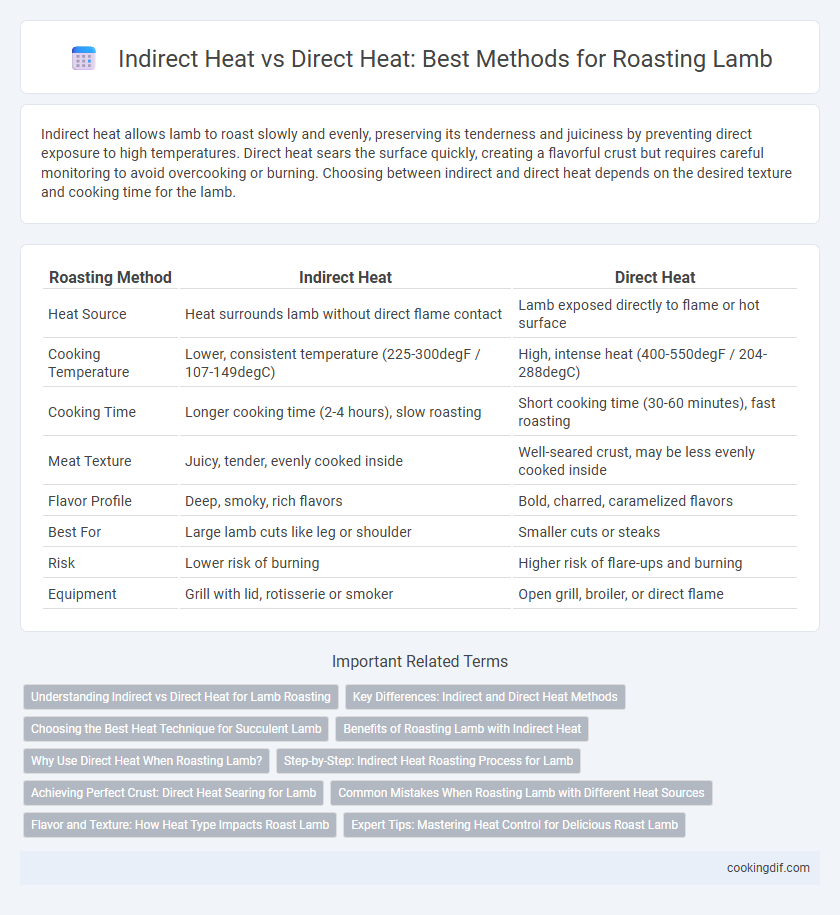Indirect heat allows lamb to roast slowly and evenly, preserving its tenderness and juiciness by preventing direct exposure to high temperatures. Direct heat sears the surface quickly, creating a flavorful crust but requires careful monitoring to avoid overcooking or burning. Choosing between indirect and direct heat depends on the desired texture and cooking time for the lamb.
Table of Comparison
| Roasting Method | Indirect Heat | Direct Heat |
|---|---|---|
| Heat Source | Heat surrounds lamb without direct flame contact | Lamb exposed directly to flame or hot surface |
| Cooking Temperature | Lower, consistent temperature (225-300degF / 107-149degC) | High, intense heat (400-550degF / 204-288degC) |
| Cooking Time | Longer cooking time (2-4 hours), slow roasting | Short cooking time (30-60 minutes), fast roasting |
| Meat Texture | Juicy, tender, evenly cooked inside | Well-seared crust, may be less evenly cooked inside |
| Flavor Profile | Deep, smoky, rich flavors | Bold, charred, caramelized flavors |
| Best For | Large lamb cuts like leg or shoulder | Smaller cuts or steaks |
| Risk | Lower risk of burning | Higher risk of flare-ups and burning |
| Equipment | Grill with lid, rotisserie or smoker | Open grill, broiler, or direct flame |
Understanding Indirect vs Direct Heat for Lamb Roasting
Indirect heat for lamb roasting involves cooking the meat away from the direct flame or heat source, allowing for slower, more even cooking that preserves juiciness and tenderness. Direct heat exposes the lamb directly to high temperatures, ideal for searing the exterior and creating a flavorful crust but risking uneven cooking and dryness if not monitored closely. Mastering the balance between indirect and direct heat ensures perfectly roasted lamb with a caramelized outer layer and a tender, juicy interior.
Key Differences: Indirect and Direct Heat Methods
Indirect heat roasting cooks lamb slowly at lower temperatures, allowing even heat distribution and tenderizing the meat without drying it out. Direct heat roasting exposes lamb to high temperatures, creating a crispy exterior and a flavorful crust through searing. Understanding these key differences helps optimize cooking time and texture, with indirect heat best for larger cuts and direct heat ideal for smaller, quick-cooking portions.
Choosing the Best Heat Technique for Succulent Lamb
Indirect heat provides a slow and even cooking environment, allowing lamb to retain moisture and develop tender, juicy meat without drying out. Direct heat, on the other hand, sears the exterior quickly, creating a flavorful crust but risks overcooking the interior if not carefully monitored. For succulent lamb, balancing both techniques by starting with indirect heat and finishing with direct heat yields optimal flavor and texture.
Benefits of Roasting Lamb with Indirect Heat
Roasting lamb with indirect heat ensures even cooking by allowing the meat to cook slowly without exposure to intense flames, preserving its tenderness and juiciness. This method reduces the risk of burning the exterior while achieving a flavorful, crispy crust due to consistent heat circulation. Indirect heat also helps in rendering fat gradually, enhancing the lamb's natural flavors and resulting in a succulent, perfectly roasted dish.
Why Use Direct Heat When Roasting Lamb?
Direct heat in roasting lamb intensifies caramelization and Maillard reactions, enhancing the crust's flavor and texture. This method sears the meat quickly, locking in juices and creating a savory, juicy interior. Utilizing direct heat ensures even cooking and a deliciously browned exterior, crucial for an optimal roast lamb experience.
Step-by-Step: Indirect Heat Roasting Process for Lamb
For roasting lamb using indirect heat, first preheat the oven to 325degF (163degC) and position the lamb on a rack away from the direct flame or heating element. Next, roast the lamb slowly to ensure even cooking, allowing the internal temperature to reach 135degF (57degC) for medium-rare or 145degF (63degC) for medium doneness. Finally, rest the roasted lamb for 15 minutes to redistribute juices before carving, resulting in tender and flavorful meat.
Achieving Perfect Crust: Direct Heat Searing for Lamb
Direct heat searing is essential for achieving a perfect crust on roasted lamb, as it rapidly caramelizes the meat's surface, locking in juices and enhancing flavor through the Maillard reaction. By applying intense, concentrated heat, the lamb develops a rich, golden-brown crust that contrasts beautifully with the tender, medium-rare interior. This method is often paired with indirect heat roasting to finish cooking evenly, ensuring both a crispy exterior and succulent center.
Common Mistakes When Roasting Lamb with Different Heat Sources
Using direct heat when roasting lamb often results in uneven cooking and a burnt exterior with an undercooked interior, a common mistake that compromises tenderness and flavor. Indirect heat allows for slower, more uniform cooking, avoiding the risk of drying out the meat or creating tough textures. Many home cooks mistakenly apply direct heat for the entire roast, neglecting to control temperature zones, which can lead to inconsistent results and diminished juiciness.
Flavor and Texture: How Heat Type Impacts Roast Lamb
Direct heat sears roast lamb, creating a flavorful caramelized crust that locks in juices, enhancing texture with a crispy exterior and tender interior. Indirect heat cooks lamb more slowly and evenly, producing a consistently tender roast with a milder, less charred flavor. The choice between direct and indirect heat significantly influences the balance of flavor intensity and meat texture in lamb roasting.
Expert Tips: Mastering Heat Control for Delicious Roast Lamb
For succulent roast lamb, mastering heat control is crucial, with indirect heat offering slow, even cooking that preserves juiciness and tenderness. Direct heat is ideal for searing, creating a flavorful crust while locking in moisture, but requires careful timing to prevent drying. Expert chefs recommend starting with direct heat to brown the lamb, then switching to indirect heat to finish cooking gently, ensuring perfect roast lamb every time.
Indirect heat vs Direct heat for roasting lamb Infographic

 cookingdif.com
cookingdif.com